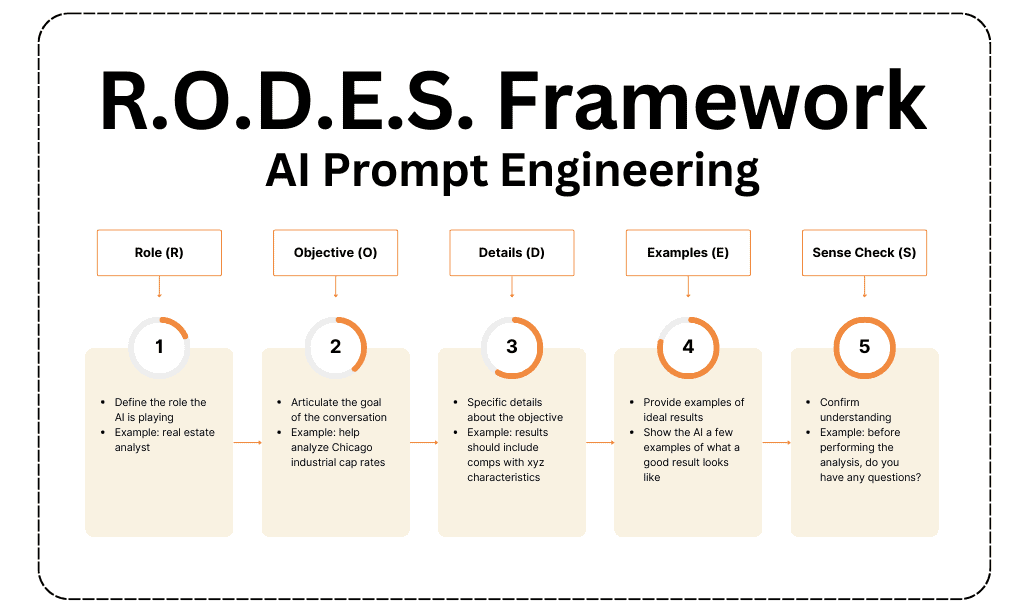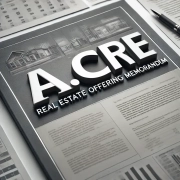AI Prompt Engineering in Commercial Real Estate: A Useful Framework
In late 2022, we at A.CRE began to dive in earnest into the world of AI. Since that time, we’ve shared numerous blog posts exploring AI use cases and training materials. We’ve also shared and built ourselves, various AI-related tools that we believe will change the face of commercial real estate. It’s been an exciting journey, filled with discoveries and insights.
One of those discoveries came from someone we follow on Twitter, Sebo (@sebo_gm). He’s also an AI enthusiast, and we’ve found his content to be incredibly insightful. He recently developed an intuitive framework for AI prompt engineering called the R.O.D.E.S. Framework, and we thought it was too good not to share with you.
So, here’s a closer look at the R.O.D.E.S. Framework and how we as commercial real estate professionals might apply this framework to produce more valuable outputs from our AI language models.

A summary of the R.O.D.E.S. framework for prompt engineering, created by Sebo (@sebo_gm)
R.O.D.E.S. Prompt Engineering Framework from a CRE Perspective
The R.O.D.E.S. Framework is a result of a lengthy review and aggregation of some of the best resources on AI prompt engineering. Sebo’s framework takes a structured approach to prompting that’s both accessible and effective. It’s about understanding the nuances of AI and applying them in a way that produces the ideal output from the language model.
Let’s delve into the R.O.D.E.S. Framework and see how you might use it to improve your prompts:
1. Role (R) – The Persona of AI
In commercial real estate, understanding the persona of your target audience is key. The same applies to AI. Define the persona you want the AI to take on. The more specific, the better.
Example: You are a seasoned real estate analyst trained to analyze market trends.
2. Objective (O) – The Goal of the Task
Just as in real estate investing, clarity in objectives is paramount. State the goal of the task as specifically as possible.
Example: I want you to analyze industrial cap rate trends in the Chicago market over the last five years.
3. Details (D) – The Blueprint of Success
In real estate, the devil is in the details – 25bps in your exit cap may be the difference between hitting a promote hurdle or not. Provide specific requirements and constraints for your request, again the more specific the better.
Example: The analysis should include data from Q1 2018 to Q1 2023, focusing on Class A industrial buildings larger than 200,000 SF.
4. Examples (E) – The Guiding Light
Offer examples of the input and output you desire. This is akin to describing the assumptions (e.g. 7.5% YoC and 5.5% market cap rate) and the resulting output (200bps development spread resulting in a 2.0x equity multiple over a 5-year hold).
Example: The result should be a comprehensive list of relevant sale comps for industrial buildings in Chicago, with accompanying sale cap rates.
5. Sense Check (S) – The Final Validation
Finally, ask the model if it understands your prompt, just as you would confirm the understanding of a complex real estate deal with a client.
Example: Before performing the analysis, do you have any questions?
Conclusion: The R.O.D.E.S. Framework in Action
The R.O.D.E.S. framework offers a structured approach to AI prompt engineering to help commercial real estate professionals better leverage natural language models like ChatGPT, Google Bard, and LLaMa Chat. Whether you’re looking to improve your own financial models, create predictive algorithms for market trends, or draft attractive marketing copy to send to clients, this framework can be your guide.
Frequently Asked Questions about AI Prompt Engineering Using the R.O.D.E.S. Framework
What is the R.O.D.E.S. framework and who created it?
The R.O.D.E.S. framework is a prompt engineering method developed by AI practitioner Sebo (@sebo_gm). It stands for Role, Objective, Details, Examples, and Sense Check—a structured approach to crafting prompts that guide AI to produce accurate and helpful outputs.
How does the "Role" part of R.O.D.E.S. improve prompting?
“Define the persona you want the AI to take on. The more specific, the better.” In commercial real estate, setting the AI’s role—such as a “seasoned real estate analyst”—helps it adopt the right voice and domain focus for your task.
What is meant by the "Objective" in the framework?
“State the goal of the task as specifically as possible.” The “Objective” tells the AI exactly what outcome you’re seeking. Example: “Analyze industrial cap rate trends in the Chicago market over the last five years.”
Why are "Details" so important in prompting AI?
“In real estate, the devil is in the details.” The more detailed your prompt, the better the AI can tailor its response. Including constraints like time frames or asset types ensures the output is relevant and aligned with your expectations.
How do "Examples" help improve AI responses?
Examples act as a “guiding light” for the AI. By showing desired input/output formats, you reduce ambiguity. For instance, providing a sample list of sale comps helps the model replicate a similar format and level of depth.
What is the purpose of a "Sense Check" in AI prompting?
It’s a validation step. The prompt “Before performing the analysis, do you have any questions?” allows the AI to confirm understanding before proceeding. This reduces errors and ensures the response meets expectations.
Why is the R.O.D.E.S. framework especially useful for CRE professionals?
“Whether you’re looking to improve your own financial models… or draft marketing copy,” R.O.D.E.S. provides a repeatable structure for making prompts that produce precise, valuable outputs for real estate-specific tasks.








